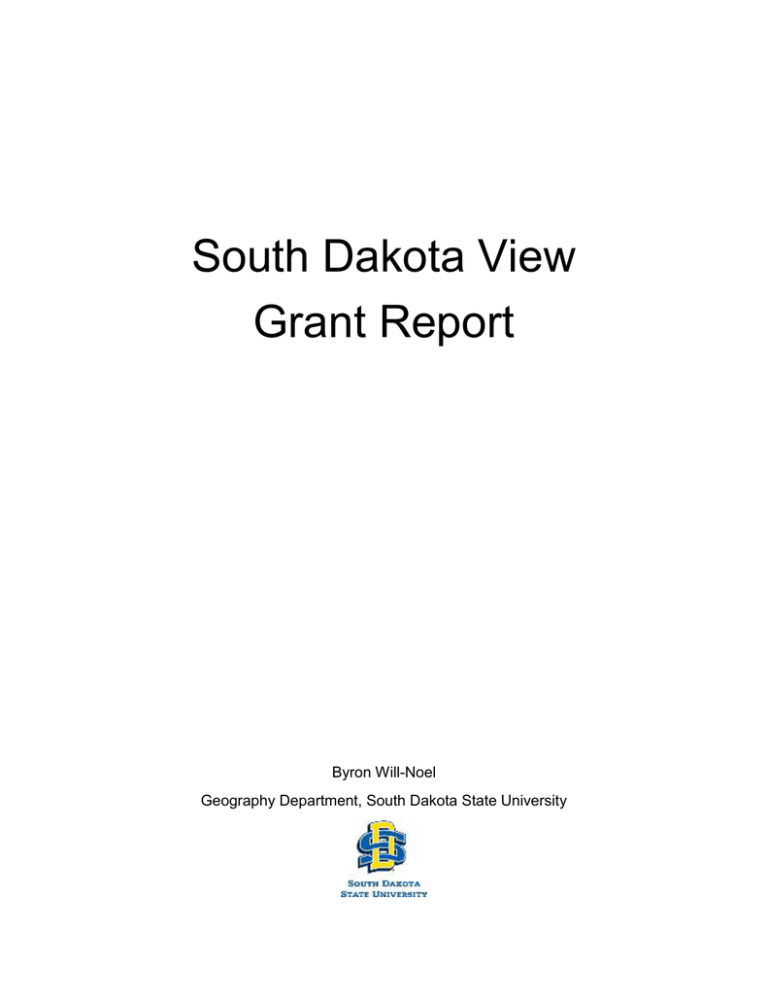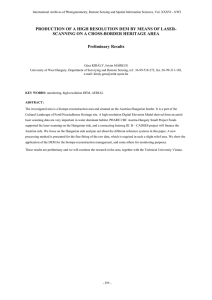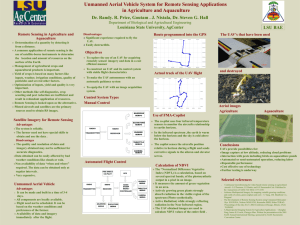Byron Will-Noel Testimony
advertisement

South Dakota View Grant Report Byron Will-Noel Geography Department, South Dakota State University 2 The goal of this project is to successfully integrate the tool that is the Unmanned Aerial System (AUS) into the already established curriculum at the SDSU Geography Department. Five lab sessions were chosen, from the Air Photo Interpretation 483 class. Lab time was scheduled for 110 concurrent minutes a week. With a limited budget, and a class size of fourteen, a qualitative approach to the labs will be taken. Outcome success will be gauged on student engagement, and student’s ability to complete assignments. The lab sessions will consist of the following: 1. Mission Planning As a result of taking this lab students will: Acquire a basic understanding of airspace rules; be able to identify suitable/unsuitable flight conditions; be able to identify potential hazards; be able to construct a basic flight plan. To this end, students will be assigned a set of questions. These will be answered by looking at the directed to FAA (Federal Aviation Administration) webpage (Fig 1). Students will then need to pass (8/10) the FAA online quiz, which is available on a partners website (knowbeforeyoufly.org). The following set of instructions sees students visually inspecting an area on campus, for a theoretical flight. Students will construct a flight plan, using Google Earth Pro and a pre-defined format. Fig. 1: Example of a completed quiz. 3 2. Orthomosaic Generation, Comparison and Interpretation As a result of taking this lab students will: Develop a knowledge of the workflow required to produce Orthomosaic image sets; get hands on experience with MS ICE (Microsoft Image Composite Editor), and Agisoft Photoscan Professional (SD View Grant); gain experience identifying errors in the imagery; understand how to identify objects; demonstrate an ability export to a file in ArcMap. Students will use pre-selected image sets, and follow instructional steps to complete the workflow required to produce full images (Fig. 2). With the ICE image, students will produce a clipped image that could be used for a visual survey. Using Photoscan, they will follow steps to produce a geo referenced TIFF file that can be exported into ArcMap. Fig. 2: Example of a point cloud model, created in Photoscan. 3. Image Acquisition As a result of taking this lab students will: be able to identify suitable camera types; understand how to set up a camera for aerial image taking; explain why 4 height, shutter speed, and wind are important to consider; gain hands on experience with alternative forms of image platforms (KAP – Kite Aerial Photography) (Fig. 3). The SD BOR will currently not allow UAV (Unmanned Aerial Vehicle) flights over campus property, or the purchase of a UAV. A kite system was chosen to simulate a UAV platform, as they would carry a similar camera type setup. Students will be taken to an open field and given a demonstration of a small UAS appropriate camera (SD View Grant). Through this students will attain the knowledge necessary to take the required pictures for accurate data, and rely this knowledge through a short report. Students will be asked to list and explain all considerations necessary for taking a good set of images. Figure 3: KAP system being launched. 5 4. NDVI and DEM Generation, and Interpretation As a result of taking this lab students will: Understand the basic concepts of NDVI (Normalized Difference Vegetation Index) and DEM’s (Digital Elevation Model’s); develop the analytical skills for basic NDVI and DEM interpretation; understand the workflow required to produce the NDVI orthomosaic with ImageJ software; be able to interpret an NDVI image; produce the workflow required to create a DEM in Photoscan; know how to export a DEM to ArcMap; have the skills needed to interpret a DEM. Students will follow instructions in order to create the Orthomosaic NDVI image, using MS ICE and ImageJ (Fig. 4). Instructions will also be given for DEM generation using Photoscan. Students will be asked interpretive questions based on both images, to test their understanding of what they are seeing and utilize knowledge acquired up to this point. Figure 4: Generated NDVI Orthomosaic. 6 5. Flight Simulator As a result of taking this lab students will: be able to recognize hazards within a simulated area of operation; launch, fly and land a simulated UAV within the AeroSim software. Students will be shown the simulated environment (countryside and city), and will perform a visual analysis of potential hazards. A short demonstration on flight control will be given. Students must partner up, with one student acting as a spotter while the other students flies the simulator. Students must demonstrate to the class instructor an ability to take-off, fly a circle around the area, and then land in the takeoff area. Figure 5: A screenshot of the AeroSim software in action 7 How did the SD View Grant help me complete this project? The help received from SD View was invaluable in the completion of this project. The Agisoft Photoscan software provided was essential for the processing of data that we can export and use. Without it students could not have learned how to create geo-referenced images using UAV data. The camera used with the kite perfectly simulated an operation with a UAV, as the principles of height transfer to both systems. Without this camera students could not have had hands on experience in dealing with the kind of sensor they would use on a UAV.



